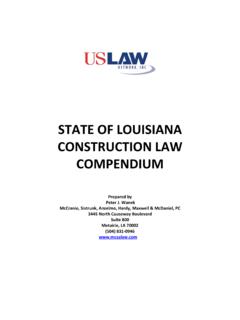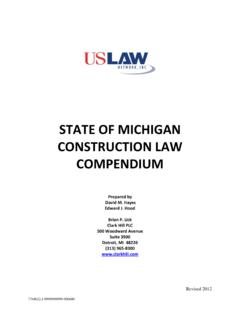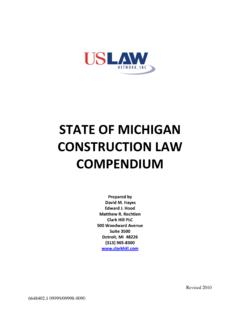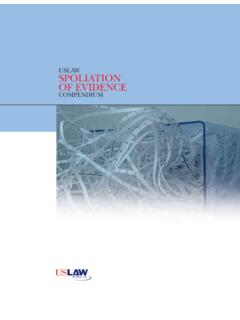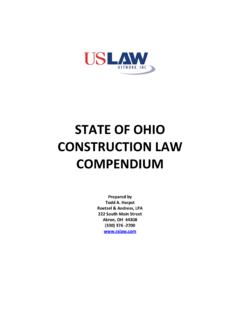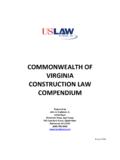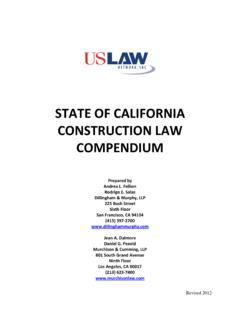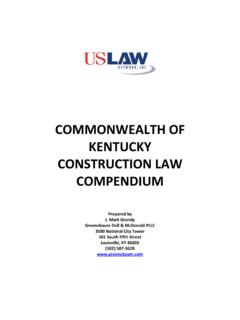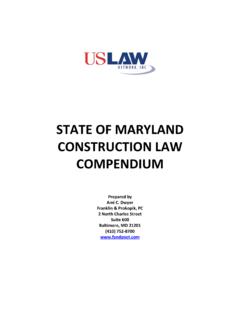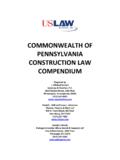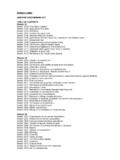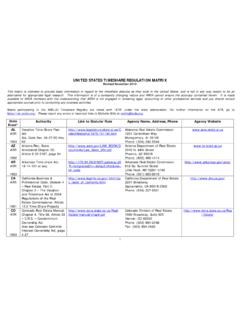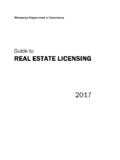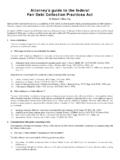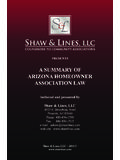Transcription of STATE OF SOUTH CAROLINA CONSTRUCTION LAW …
1 STATE OF SOUTH CAROLINA CONSTRUCTION LAW COMPENDIUM Prepared by Everett A. Kendall, II Christy E. Mahon Sweeny, Wingate, & Barrow, 1515 Lady Street Post Office Box 12129 Columbia, SC 29211 (803) 256 2233 F. Cordes Ford, IV Buist Moore Smyth McGee 5 Exchange Street Charleston, SC 29401 (843) 722 3400 2 SOUTH CAROLINA is a comparative negligence STATE . A plaintiff in SOUTH CAROLINA may recover only if his/her negligence does not exceed that of the defendant's and amount of plaintiff's recovery shall be reduced in proportion to amount of his or her negligence; if there is more than one defendant, plaintiff's negligence shall be compared to combined negligence of all defendants. Nelson v. Concrete Supply Co., 303 243, 399 783 (1991). The law governing joint and several liability has been amended. Code Ann. Section 15-38-15 took effect on July 1, 2005, and applies to causes of action arising on or after that date except for causes of actions relating to CONSTRUCTION torts which would take effect on July 1, 2005, and apply to improvements to real property that first obtain substantial completion on or after July 1, 2005.
2 For improvements that obtain substantial completion prior to July 1, 2005, there is pro rata contribution among persons jointly and severally liable in tort except for cases involving an intentional tort or breaches of trust or other fiduciary obligation. Under the 2005 amendments to the SOUTH CAROLINA Contribution Among Tortfeasors Act, in an action to recover damages resulting from personal injury, wrongful death, or damage to property or to recover damages for economic loss or for noneconomic loss such as mental distress, loss of enjoyment, pain, suffering, loss of reputation, or loss of companionship resulting from tortious conduct, if indivisible damages are determined to be proximately caused by more than one defendant, joint and several liability does not apply to any defendant whose conduct is determined to be less than 50% of the total fault for the indivisible damages as compared with the total of: (i) the fault of all the defendants; and (ii) the fault (comparative negligence), if any, of the plaintiff.
3 A defendant whose conduct is determined to be less than 50% of the total fault shall only be liable for that percentage of the indivisible damages determined by the jury or trier of fact. A defendant shall retain the right to assert that another potential tortfeasor, whether or not a party, contributed to the alleged injury or damages and/or may be liable for any or all of the damages alleged by any other party. These provisions do not apply to a defendant whose conduct is determined to be wilful, wanton, reckless, grossly negligent, or intentional or conduct involving the use, sale, or possession of alcohol or the illegal or illicit use, sale, or possession of drugs. I. Breach of Contract A breach of contract claim can be asserted by the purchaser against the general contractor, as well as by the general contractor against its subcontractors. A breach of contract claim in SOUTH CAROLINA is subject to a three year statute of limitations.
4 See Code Ann. Section 15-3-530. II. Negligence In order to prove negligence, a plaintiff must show: (1) defendant owes a duty of care to the plaintiff; (2) defendant breached the duty by a negligent act or omission; (3) defendant's breach was the actual and proximate cause of the plaintiff's injury; and (4) plaintiff suffered an injury or damages. Doe v. Marion, 373 390, 645 245 (2007). The causative violation of a statute constitutes negligence per se and is evidence of recklessness and 3 willfulness, requiring the submission of the issue of punitive damages to the jury. Wise v. Broadway, 315 273, 433 857 (1993). Violation of a statute does not constitute recklessness, willfulness, and wantonness per se, but is some evidence that the defendant acted recklessly, willfully, and wantonly. Id. It is always for the jury to determine whether a party has been reckless, willful, and wanton.
5 Id. However, it is not obligatory as a matter of law for the jury to make such a finding in every case of a statutory violation. Id.; see also Nguyen v. Uniflex Corp., 312 417, 440 887 (Ct. App. 1994) (generally, the determination of whether a statute has been violated is a question of fact for the jury; additionally, whether the violation of the statute is the proximate cause of an injury is also ordinarily a jury issue). III. Breach of Warranty In CONSTRUCTION cases, plaintiffs typically assert causes of action for breach of warranty. The breach of warranty can be based on express warranty provisions contained in the contract between the plaintiff and the general contractor and/or warranties implied by law. Three year statute of limitations is applicable (when knew or should have known). A builder who contracts to construct a dwelling impliedly warrants that the work undertaken will be performed in a careful, diligent, workmanlike manner.
6 Smith v. Breedlove, 377 415, 661 67 (Ct. App. 2008). This is distinct from an implied warranty of habitability, which arises solely out of the sale of the home. Id. Although the warranty of workmanlike service arises out of the CONSTRUCTION contract to which the builder is a party, a subsequent purchaser may sue a professional builder on the implied warranty of workmanlike service despite the lack of contractual privity. Id.; see also Fields v. J. Haynes Waters Builders, Inc., 376 545, 658 80 (2008) ( this Court has embraced the notion that in constructing a home, a builder warrants that the home is fit for its intended use as a dwelling, that the home was constructed in a workmanlike manner, and that the home is free of latent defects. This warranty extends not only to the original purchasers of the home, with whom the builder is in privity, but to subsequent purchasers who may pursue a cause of action in contract or tort against a builder for a reasonable period after the home's CONSTRUCTION .)
7 One who provides plans and specifications to a contractor and undertakes to oversee the project impliedly warrants the accuracy of those plans in their purpose and view. Tommy L. Griffin Plumbing & Heating Co. v. Jordan, Jones & Goulding, Inc., 320 49, 463 85 (1995); Hill v. Polar Pantries, 219 263, 64 885 (1951) (one who undertook to design and oversee a CONSTRUCTION project for another impliedly warranted the design and quality of CONSTRUCTION despite the lack of privity between the parties); Beachwalk Villas Condominium Association v. Martin, 305 144, 406 372 (1991) (if a party furnishes plans and specifications for a contractor to follow in a CONSTRUCTION job, he thereby impliedly warrants their sufficiency for the purpose in view). The Uniform Commercial Code establishes three types of warranty: the implied warranty of merchantability, implied warranty for fitness for a particular purpose, and express warranty.
8 If the predominant factor of the transaction is the rendition of a service with goods incidentally involved, the UCC is not applicable. Plantation Shutter Co., Inc. v. Ezell, 328 475, 492 404 (Ct. 4 App. 1997). If, however, the contract's predominant factor is the sale of goods with labor incidentally involved, the UCC applies. Id. In most cases in which the contract calls for a combination of services with the sale of goods, courts have applied the UCC. Id. In considering whether a transaction that provides for both goods and services is a contract for the sale of goods governed by the UCC, courts generally employ the predominant factor test. Id. (contract for special manufacture and installation of shutters for home was predominantly contract for sale of goods, and thus was governed by SOUTH CAROLINA version of UCC; while contract did authorize work to be performed, contract was entitled Terms of Sale, and did not provide for installation charges); see also Code Ann.
9 Section 36-2-725 (1) ( An action for breach of any contract for sale must be commenced within six years after the cause of action has accrued. ). IV. Misrepresentation and Fraud In a case of actual fraud, based upon representation, there are nine elements essential to recovery, which are: (1) a representation; (2) its falsity; (3) its materiality; (4) either knowledge of its falsity or a reckless disregard of its truth or falsity; (5) intent that the representation be acted upon; (6) the hearer's ignorance of its falsity; (7) the hearer's reliance on its truth; (8) the hearer's right to rely thereon; and (9) the hearer's consequent and proximate injury. Carter v. Boyd Const. Co., 255 274, 178 536 (1971). Further, SOUTH CAROLINA recognizes the common law tort of negligent misrepresentation. See deBondt v. Carlton Motorcars, Inc., 342 254, 536 399 (Ct. App. 2000). Where the damage alleged by the plaintiff is a pecuniary loss, the plaintiff must prove the following elements for negligent misrepresentation: (1) the defendant made a false representation to the plaintiff; (2) the defendant had a pecuniary interest in making the statement; (3) the defendant owed a duty of care to see that he communicated truthful information to the plaintiff; (4) the defendant breached that duty by failing to exercise due care; (5) the plaintiff justifiably relied on the representation; and (6) the plaintiff suffered a pecuniary loss as the proximate result of his reliance upon the representation.
10 Id. For purposes of proving negligent misrepresentation, evidence that a statement was made in the course of the defendant's business, profession, or employment is sufficient to prove the defendant's pecuniary interest in making the statement, even though the defendant received no consideration for it. Id. Historically, the Supreme Court of SOUTH CAROLINA has held that a punitive damage award is warranted only when the defendant's conduct is shown to be willful, wanton, or in reckless disregard of the rights of others. Wise v. Broadway, 315 273, 433 857 (1993). Punitive damages are not recoverable in an action based on negligent conduct. Harold Tyner Development Builders, Inc. v. Firstmark Development Corp., 311 447, 429 819 (Ct. App. 1993); see Lengel v. Tom Jenkins Realty, Inc., 286 515, 334 834 (Ct. App. 1985) (verdict for plaintiff on a cause of action for negligent misrepresentation did not support an award of punitive damages in the absence of proof of a willful, wanton, or reckless act).
